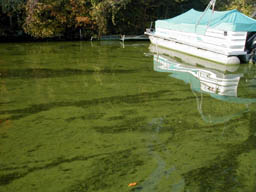Nearly every year, local boaters, anglers and lakeside homeowners have their summer fun spoiled by massive blooms of slimy, smelly algae in Ford and Belleville lakes. Now, a U-M research project is hinting at ways to control the problem and showing how state-of-the-art science might reform lake management practices that currently are rooted in outdated theories.

“Both Ford and Belleville lakes apparently have been developing these nuisance blooms since the lakes were created in the early 20th century to generate hydroelectric power,” says John Lehman, professor of ecology and evolutionary biology. But the messy mats of algae that appear during late summer have become more of a concern as homes have sprung up around the lakes and recreational use has increased.
For the past decade, the Michigan Department of Environmental Quality (DEQ) has monitored and regulated the amount of phosphorus coming into the lakes from wastewater treatment plants upstream on the Huron River, based on the belief that phosphorus is the nutrient that most affects the growth of algae.
“But there’s no evidence of any improvement over that 10-year period,” Lehman says. “The nuisance blooms that are developing now are every bit as bad as the ones that were occurring prior to implementation of this management strategy.”
Lehman decided to apply his scientific savvy to the problem after serving on the Huron River Watershed Council a few years ago.
“When I started to learn about the issues, I realized that the management strategy that the DEQ had put in place didn’t seem to reflect the modern theory of nuisance algal growth,” he says.
Understanding the connection between phosphorus and algal growth was something of a scientific breakthrough 30 years ago, but scientists now know the picture is considerably more complicated. In the modern view, “it’s not necessarily the total amount of algae that develops in a lake that creates problems; it’s the particular kinds of algae that you get,” Lehman says, and that mix is influenced not by phosphorus alone, but by the ratio of nitrogen to phosphorus.

“If there’s a lot of nitrogen in proportion to phosphorus, then species other than the bloom-forming species will dominate,” he says.
These non-nuisance species of algae actually can be good for lakes because other organisms eat the algae, and fish eat the other organisms. But the messy, mat-forming species, which are called blue-green algae but actually are bacteria, are less palatable and don’t get eaten.
By monitoring weather conditions, measuring amounts of nitrogen, phosphorus and various metals in the lakes and river, and setting up algae-growing experiments, Lehman’s team is learning more about what triggers nuisance blooms.
Their three-year study, funded by the U.S. Environmental Protection Agency, is beginning its second year, and already the researchers have new insights. They’ve found, for example, that concentrations of nitrate—a form of nitrogen—drop to zero in Ford Lake during the course of the summer. That’s bad for the good algae, which require their nitrogen in the form of nitrate, but it’s an advantage for the blue-greens, which are capable of taking nitrogen straight from the atmosphere or extracting it from ammonia.
Seasonal weather changes and lake management practices enter in because they can contribute to processes that cause nitrate levels to drop. In winter and spring, water flows rapidly down the river into the lakes. In order to keep lake levels relatively constant, lake managers open gates at the bottoms of the dams, allowing water to escape from deeper reaches of the lakes. But during a dry summer, managers close the bottom gates, drawing water only from the surface to operate the turbines of the lakes’ hydroelectric plants.
“That creates the potential for a stagnant layer of water to build up in the bottom of the lake, particularly during times of drought,” Lehman says. Under these conditions, oxygen disappears from the lower layer of water, large amounts of phosphorus and ammonia are released from the mud, and chemical processes are set in motion that use up all the nitrate, favoring the growth of nuisance blue-green algae over more desirable species. When a big storm or cold front comes along, the lake gets churned up and the undesirable algae take over the upper layer as well.
“The trick is to keep that bottom stagnant layer from ever establishing itself, because once it does, it’s a time bomb, and there’s no real stopping it,” Lehman says.

